Experimental Study on the Effect of Gas Adsorption and Desorption on Ultrasonic Velocity and Elastic Mechanical Parameters of Coal
Abstract
1. Introduction
2. Materials and Methods
2.1. Experimental Equipment
2.2. Principle of Measurement
2.3. Coal Sample Collection and Processing
2.4. Experimental Protocol and Experimental Steps
- Evacuation stage (I)
- Gas injection and adsorption stage (II)
- Pressure reduction and desorption stage (III)
3. Results and Discussion
3.1. Results from Experiments and Determination of Elastic Mechanical Characteristics
3.2. Changes in the Ultrasonic Velocity of Coal Samples during Gas Adsorption and Desorption
3.3. Changes in the Elastic Mechanical Parameters of Coal Samples during Gas Adsorption and Desorption
3.4. The Mechanism of How Gas Adsorption and Desorption Affect the Coal’s Ultrasonic Velocity
- The gas−bearing coal’s pores and cracks were investigated, and their porosity was quantified.
- Gas containing coal underwent linear elastic minor deformation.
- It was a homogenous continuous isotropic medium that included coal.
- Gas containing coal exhibits a stress−strain relationship that abides with the generalized Hooke’s law.
3.5. Mechanisms through Which Variations in the Elastic Mechanical Properties of Coal Masses Are Influenced by Gas Adsorption and Desorption
4. Conclusions
Author Contributions
Funding
Institutional Review Board Statement
Informed Consent Statement
Data Availability Statement
Acknowledgments
Conflicts of Interest
References
- Liu, P.; Liu, A.; Zhong, F.; Jiang, Y.; Li, J. Pore/fracture structure and gas permeability alterations induced by ultrasound treatment in coal and its application to enhanced coalbed methane recovery. J. Pet. Sci. Eng. 2021, 205, 108862. [Google Scholar] [CrossRef]
- Wang, X.; Wang, E.; Liu, X.; Zhou, X. Failure mechanism of fractured rock and associated acoustic behaviors under different loading rates. Eng. Fract. Mech. 2021, 247, 107674. [Google Scholar] [CrossRef]
- Kong, X.; He, D.; Liu, X.; Wang, E.; Li, S.; Liu, T.; Ji, P.; Deng, D.; Yang, S. Strain characteristics and energy dissipation laws of gas-bearing coal during impact fracture process. Energy 2022, 242, 123028. [Google Scholar] [CrossRef]
- Liu, X.; Jia, T.; Wei, J.; Wei, G.; Yan, J.; Wu, C. Modeling and evolution characteristics of coal reservoir energy during gas and water production. J. Nat. Gas Sci. Eng. 2021, 96, 104329. [Google Scholar] [CrossRef]
- Zhou, A.; Du, C.A.; Wang, K.; Hu, J.; Fan, X. Experimental research on the law of the deformation and damage characteristics of raw coal/briquette adsorption-instantaneous pressure relief. Fuel 2022, 308, 122062. [Google Scholar] [CrossRef]
- Yuan, L. Strategies of high efficiency recovery and energy saving for coal resources in China. J. Southwest Pet. Univ. Sci. Technol. Ed. 2018, 20, 3–12. [Google Scholar] [CrossRef]
- Liu, X.; Zhang, F.; Ma, G.; Su, X. Analysis and applied study on key factors of coal and rock crack network reconstruction. Coal Sci. Technol. 2017, 45. 85–89+169. [Google Scholar] [CrossRef]
- Wang, X.; Asem, P.; Hu, C.; Labuz, J.F. Microcracking in tensile fracture of a brittle rock. Eng. Fract. Mech. 2021, 251, 107789. [Google Scholar] [CrossRef]
- Cheng, L.; Wang, Y.; Zhang, Y.; Zhao, H. The present situation and prospect of the acoustic properties research in coal. Prog. Geophys. 2013, 28, 452–461. [Google Scholar] [CrossRef]
- Shen, X.; Xiong, Q.; Shi, W.; Liang, S.; Shi, X.; Wang, K. A New Algorithm for Reconstructing Two-Dimensional Temperature Distribution by Ultrasonic Thermometry. Math. Probl. Eng. 2015, 2015, 916741. [Google Scholar] [CrossRef][Green Version]
- Karacan, C.Ö. Swelling-induced volumetric strains internal to a stressed coal associated with CO2 sorption. Int. J. Coal Geol. 2007, 72, 209–220. [Google Scholar] [CrossRef]
- Li, H.; Lin, B.; Yang, W.; Zheng, C.; Hong, Y.; Gao, Y.; Liu, T.; Wu, S. Experimental study on the petrophysical variation of different rank coals with microwave treatment. Int. J. Coal Geol. 2016, 154–155, 82–91. [Google Scholar] [CrossRef]
- Liu, P.; Fan, L.; Fan, J.; Zhong, F. Effect of water content on the induced alteration of pore morphology and gas sorption/diffusion kinetics in coal with ultrasound treatment. Fuel 2021, 306, 121752. [Google Scholar] [CrossRef]
- Wang, L.L.; Vandamme, M.; Pereira, J.M.; Dangla, P.; Espinoza, N. Permeability changes in coal seams: The role of anisotropy. Int. J. Coal Geol. 2018, 199, 52–64. [Google Scholar] [CrossRef]
- Biot, M.A. Theory of propagation of elastic waves in a fluid-saturated porous solid. I. Low-frequency range. J. Acoust. Soc. Am. 1956, 28, 168–178. [Google Scholar] [CrossRef]
- Busch, A.; Gensterblum, Y.; Krooss, B.M.; Siemons, N. Investigation of high-pressure selective adsorption/desorption behaviour of CO2 and CH4 on coals: An experimental study. Int. J. Coal Geol. 2006, 66, 53–68. [Google Scholar] [CrossRef]
- Liu, P.; Qin, Y.; Liu, S.; Hao, Y. Non-linear gas desorption and transport behavior in coal matrix: Experiments and numerical modeling. Fuel 2018, 214, 1–13. [Google Scholar] [CrossRef]
- Mao, Y.; Chen, Y.; Bu, X.; Xie, G. Effects of 20 kHz ultrasound on coal flotation: The roles of cavitation and acoustic radiation force. Fuel 2019, 256, 115938. [Google Scholar] [CrossRef]
- Pan, Z.; Connell, L.D. A theoretical model for gas adsorption-induced coal swelling. Int. J. Coal Geol. 2007, 69, 243–252. [Google Scholar] [CrossRef]
- Wang, G.X.; Wei, X.R.; Wang, K.; Massarotto, P.; Rudolph, V. Sorption-induced swelling/shrinkage and permeability of coal under stressed adsorption/desorption conditions. Int. J. Coal Geol. 2010, 83, 46–54. [Google Scholar] [CrossRef]
- Liu, S.; Zhao, Q.; Zhang, P.; Guo, L. Test and research on relationship between seam gas features and vibration wave parameters. Coal Sci. Technol. 2005, 33, 33–36. [Google Scholar] [CrossRef]
- Zhao, Q.; Hou, Y.; Liu, S. The pilot study on characteristics of the seismic wave spectrum and gas content of coal seam. J. Henan Polytech. Univ. 2008, 27, 615–618. [Google Scholar] [CrossRef]
- Liu, W. Geophysical response characteristics of coalbed methane. Lithol. Reserv. 2009, 21, 113–115. [Google Scholar] [CrossRef]
- Liu, S.; Zhao, Q.; Zhang, P.; Guo, L. Study on Gas Content and the Attenuation Characteristics of Coal Seams of Huainan Xinzhuangzi Mine. J. Anhui Univ. Sci. Technol. Nat. Sci. 2005, 25, 1–4. [Google Scholar] [CrossRef]
- Wang, Z.; Liu, S.; Lu, T.; Zhang, P.; Zhao, L. Experimental study on the relationships of coal gas and seismic attributes. Coal Geol. Explor. 2011, 39, 63–65. [Google Scholar] [CrossRef]
- Wang, Z.; Liu, S.; Zhang, X. Correlation analysis of apparent seismic wave speeds and gas parameters in front of the coal roadway. Prog. Geophys. 2012, 27, 349–354. [Google Scholar] [CrossRef]
- Zhang, P.; Liu, S.; Qiufang, Z.; Guo, L. Factor analysis on seam reduced features and quality in Huainan Mining Area. Coal Sci. Technol. 2006, 34, 83–85. [Google Scholar] [CrossRef]
- Jiang, L.; Shi, X. Relation between wave velocity in sandstone and fluid content in porous medium under high frequency condition. Oil Geophys. Prospect. 1998, 33, 355–362. [Google Scholar] [CrossRef]
- Hao, J. Experimental research on ultrasonic elastic characteristics of outburst coal. Master’s Thesis, China University of Mining and Technology, Xuzhou, China, 2019. [Google Scholar]
- Yu, H. Ultrasonographic Features and Mechanism of Anisotropic about the Coal Containing Nitrogen (Water). Master’s Thesis, Henan Polytechnic University, Jiaozuo, China, 2016. [Google Scholar]
- Xu, G.; Deng, X.; Zhang, K.; Liu, W. Research on propagation law of waves in coal seam containing gas. Saf. Coal Mines 2009, 40, 1–4. [Google Scholar] [CrossRef]
- Xu, X. Research on the Ultrasonic Characteristics of Coal Under Normal Temperature and Pressure Conditions. Master’s Thesis, Henan Polytechnic University, Jiaozuo, China, 2013. [Google Scholar]
- Zhao, Y.; Zhang, Y.; Wang, S. Experimental Study on Ultrasonic Anisotropic Characteristics of Nitrogen-containing Coal Bodies. J. Southwest Pet. Univ. Sci. Technol. Ed. 2018, 40, 83–90. [Google Scholar] [CrossRef]
- Geotechnical Investigation and Testing—Sampling Methods and Groundwater Measurements—Part 1: Technical Principles for the Sampling of Soil, Rock and Groundwater; International Organization for Standardization: Geneva, Switzerland, 2021.
- Wang, Y.; Xu, X.; Zhang, Y. Characteristics of P-wave and S-wave velocities and their relationships with density of six metamorphic kinds of coals. Chin. J. Geophys. 2012, 55, 3754–3761. [Google Scholar] [CrossRef]
- Law, B.E.; Rice, D.D. Hydrocarbons from Coal; American Association of Petroleum Geologists: Tulsa, OK, USA, 1993. [Google Scholar]
- Kong, X.; Wang, E.; Li, S.; Lin, H.; Xiao, P.; Zhang, K. Fractals and chaos characteristics of acoustic emission energy about gas-bearing coal during loaded failure. Fractals 2019, 27, 1950072. [Google Scholar] [CrossRef]
- Jia, L.; Yu, Y.; Li, Z.-P.; Qin, S.-N.; Guo, J.-R.; Zhang, Y.-Q.; Wang, J.-C.; Zhang, J.-C.; Fan, B.-G.; Jin, Y. Study on the Hg0 removal characteristics and synergistic mechanism of iron-based modified biochar doped with multiple metals. Bioresour. Technol. 2021, 332, 125086. [Google Scholar] [CrossRef] [PubMed]
- Lu, P.; Sheng, Z.; Zhu, G.; Fang, E. The effective stress and mechanical deformation and damage characteristics of gas-filled coal. J. Univ. Sci. Technol. China 2001, 31, 686–693. [Google Scholar] [CrossRef]
- Wu, S.; Zhao, W. Analysis of effective stress in adsorbed methane-coal system. Chin. J. Rock Mech. Eng. 2005, 24, 1674–1678. [Google Scholar] [CrossRef]
- Li, P.; Kong, X.; Lu, D. Mathematical modeling of flow in saturated porous media on account of fluid-structure coupling effect. Chin. J. Hydrodyn. 2003, 18, 419–426. [Google Scholar] [CrossRef]
- Han, X.; Xu, D.; Guo, J.; Yang, L.; Wang, Z.; Zhang, D.; Luo, X.; Nie, J.; Li, H.; Jiang, J. Rock physics modelling for acoustic velocities of sandstone considering effects of cementation and compaction. Chin. J. Geophys. 2018, 61, 5044–5051. [Google Scholar] [CrossRef]
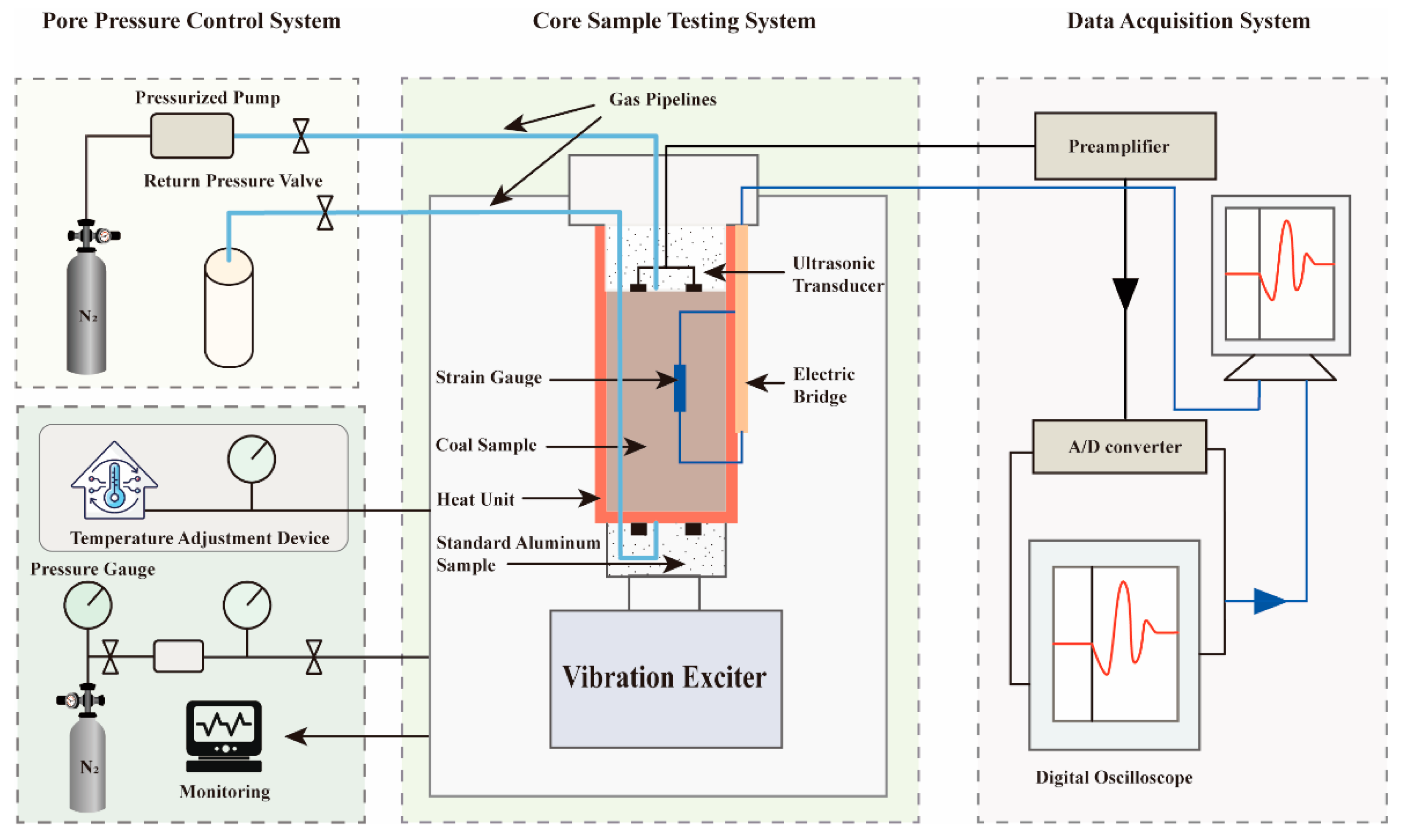
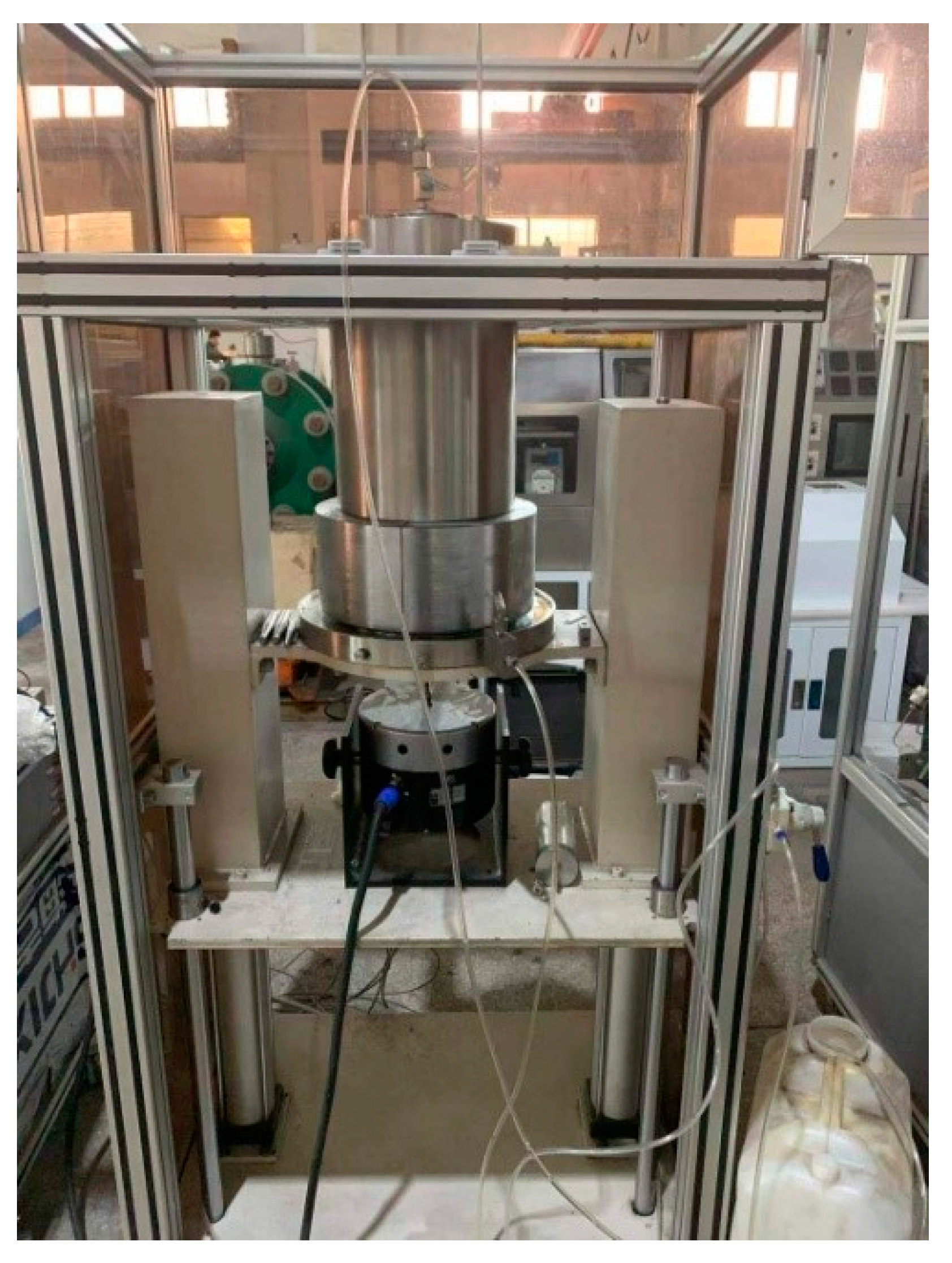
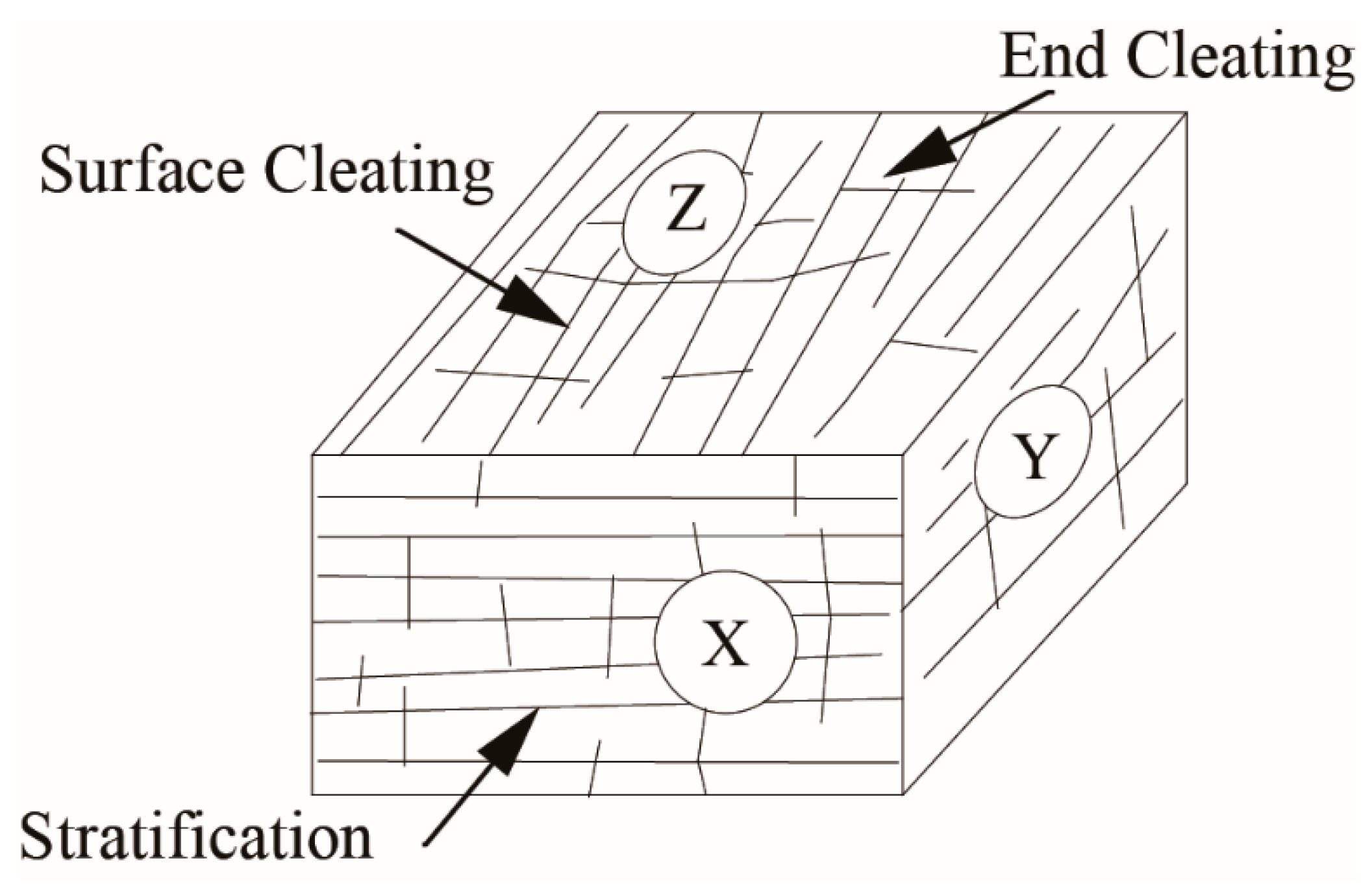
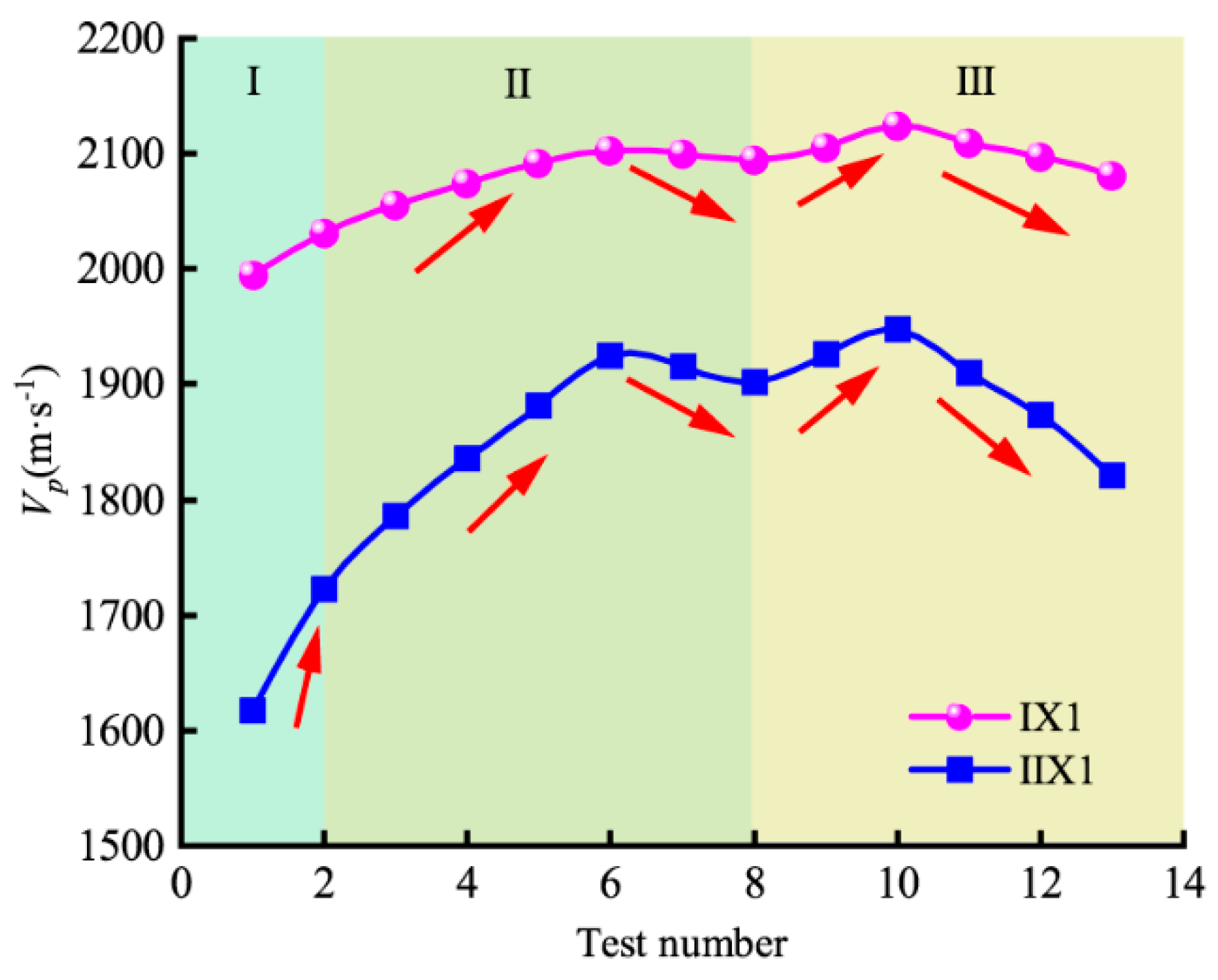
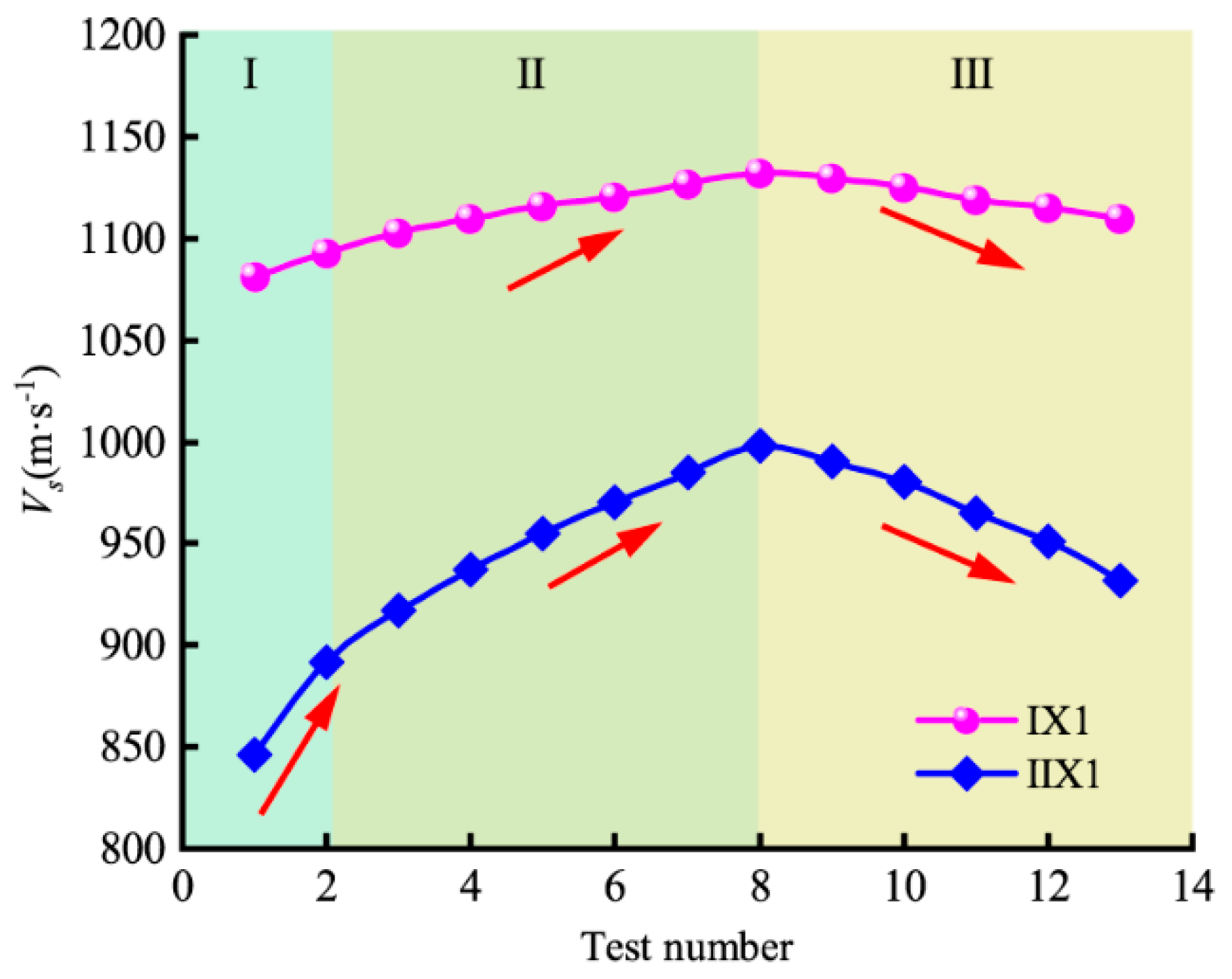

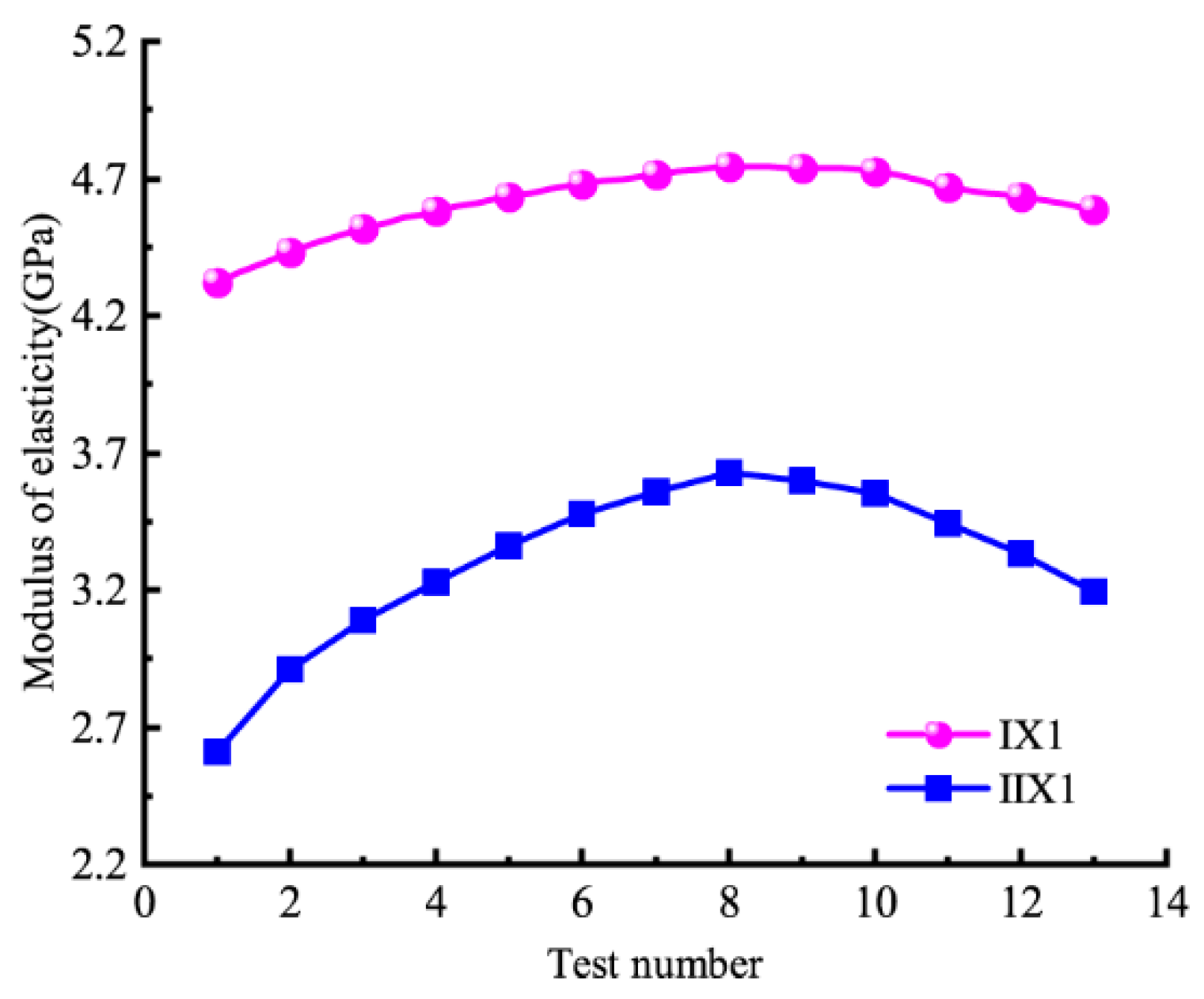
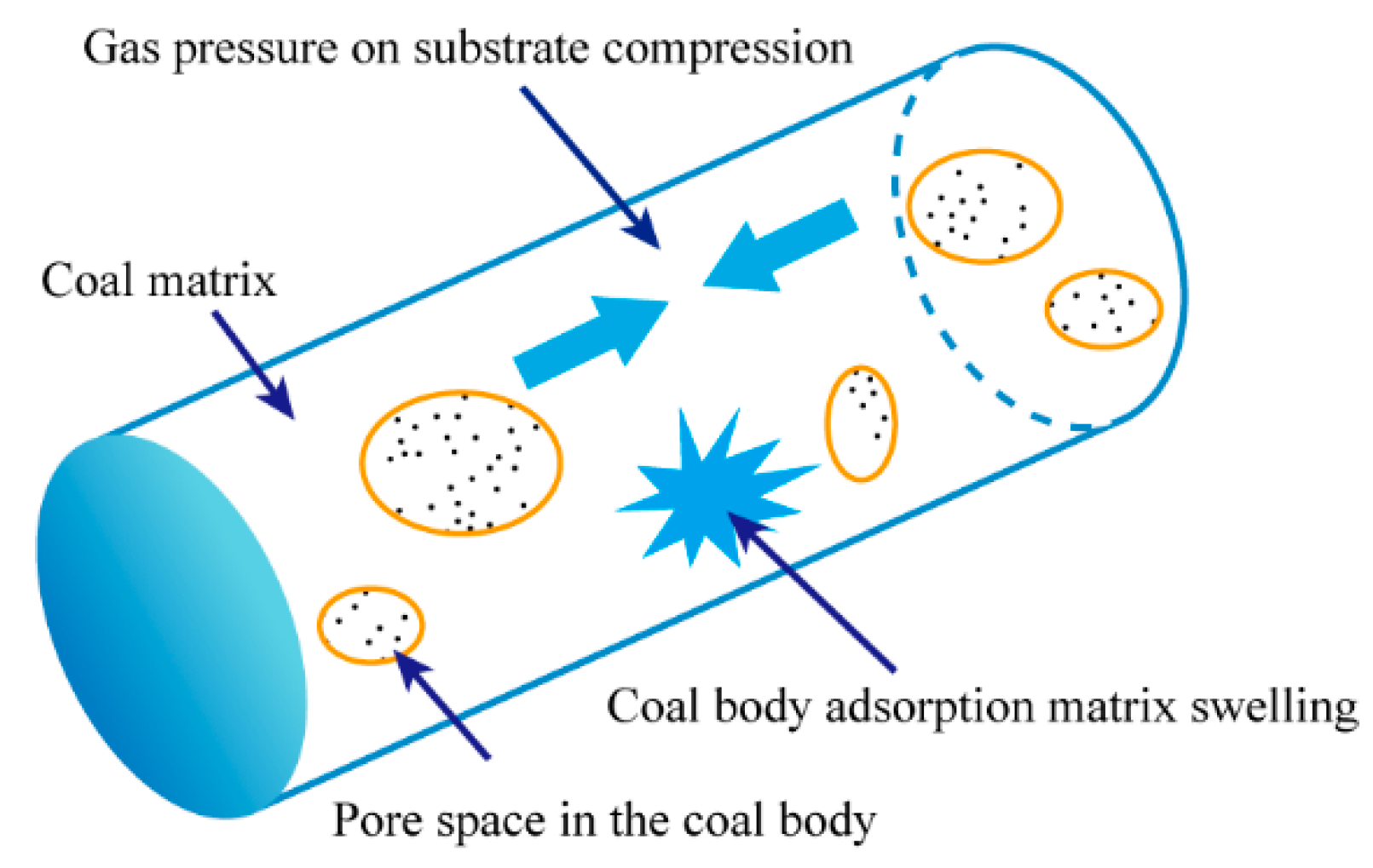
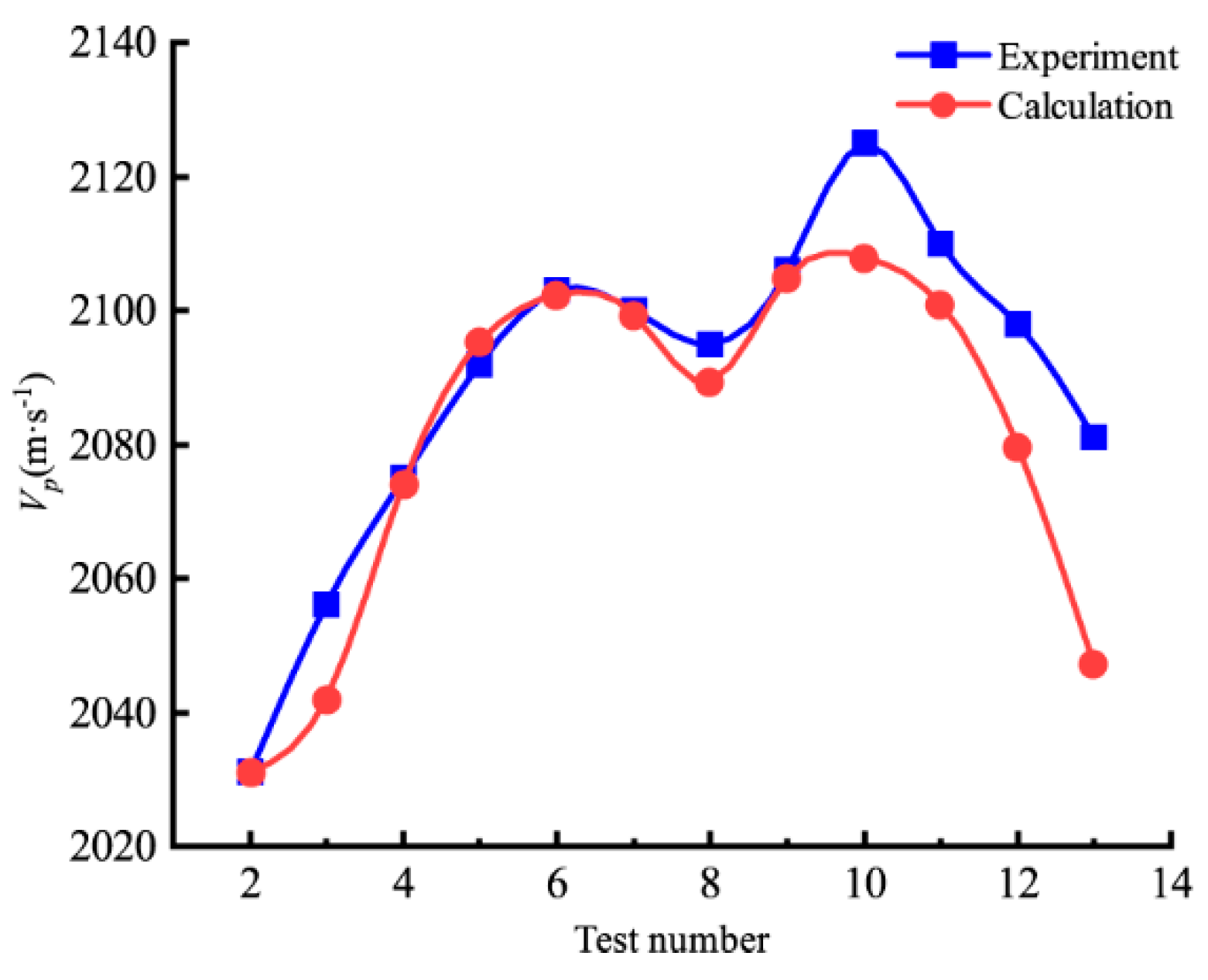
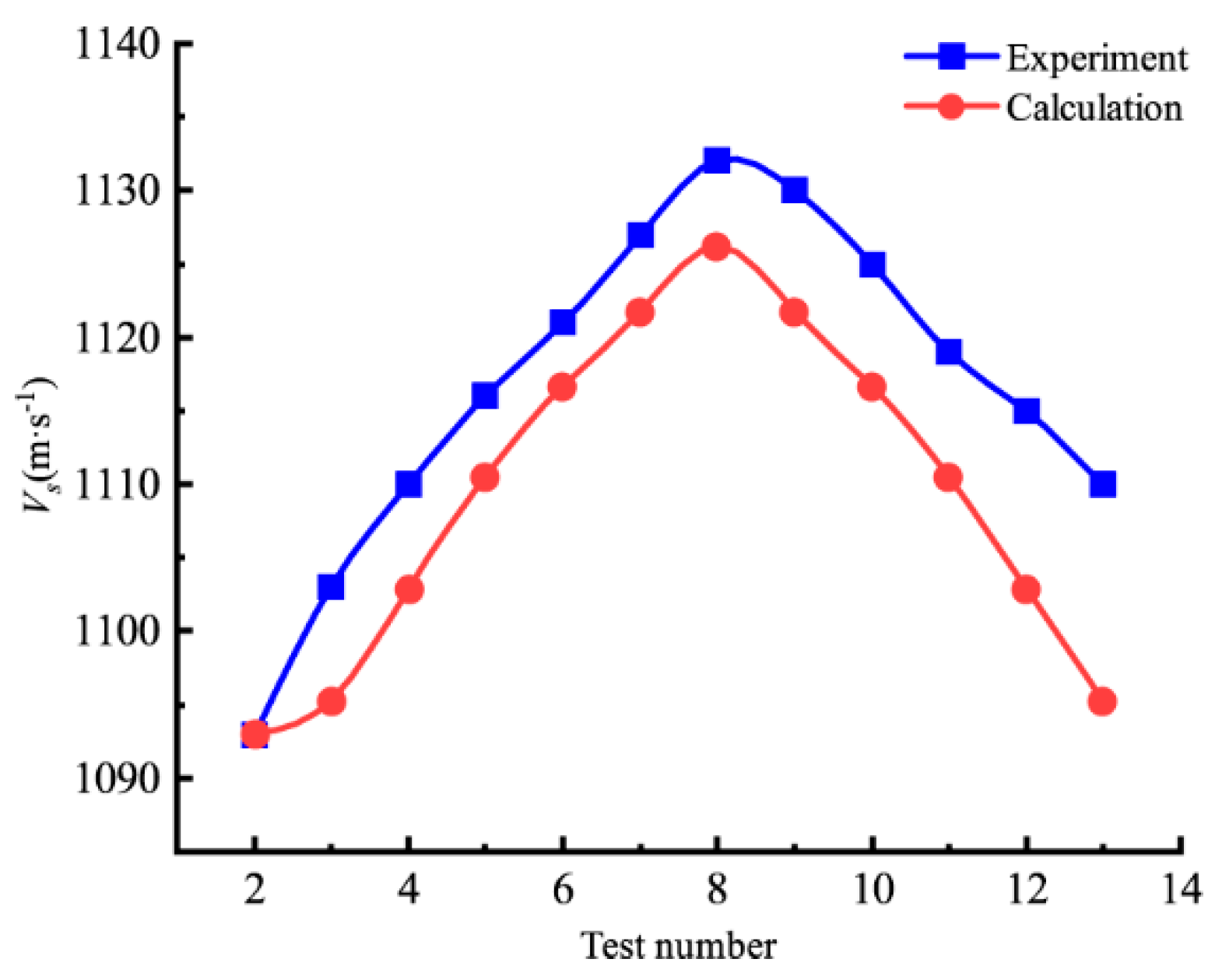
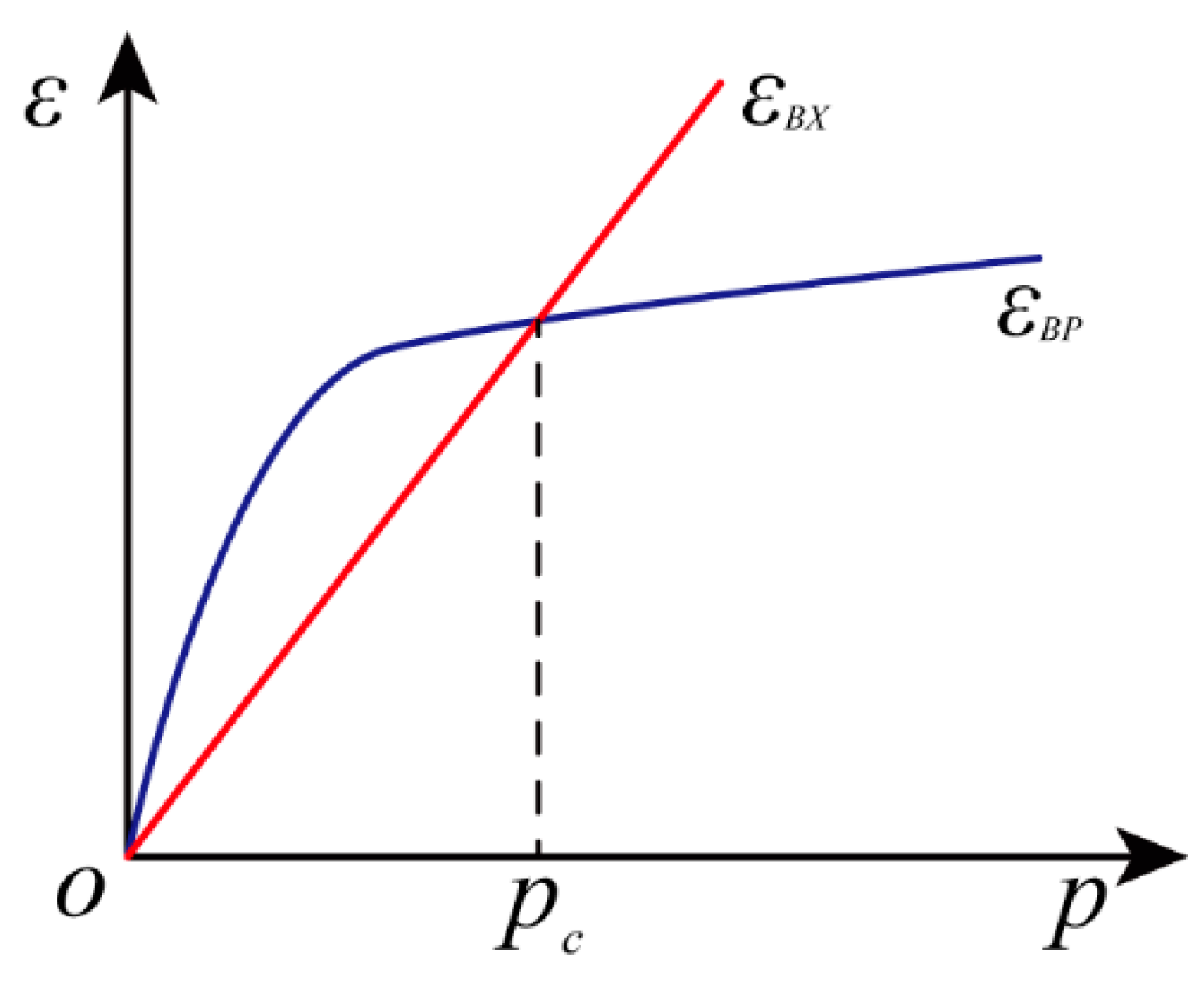
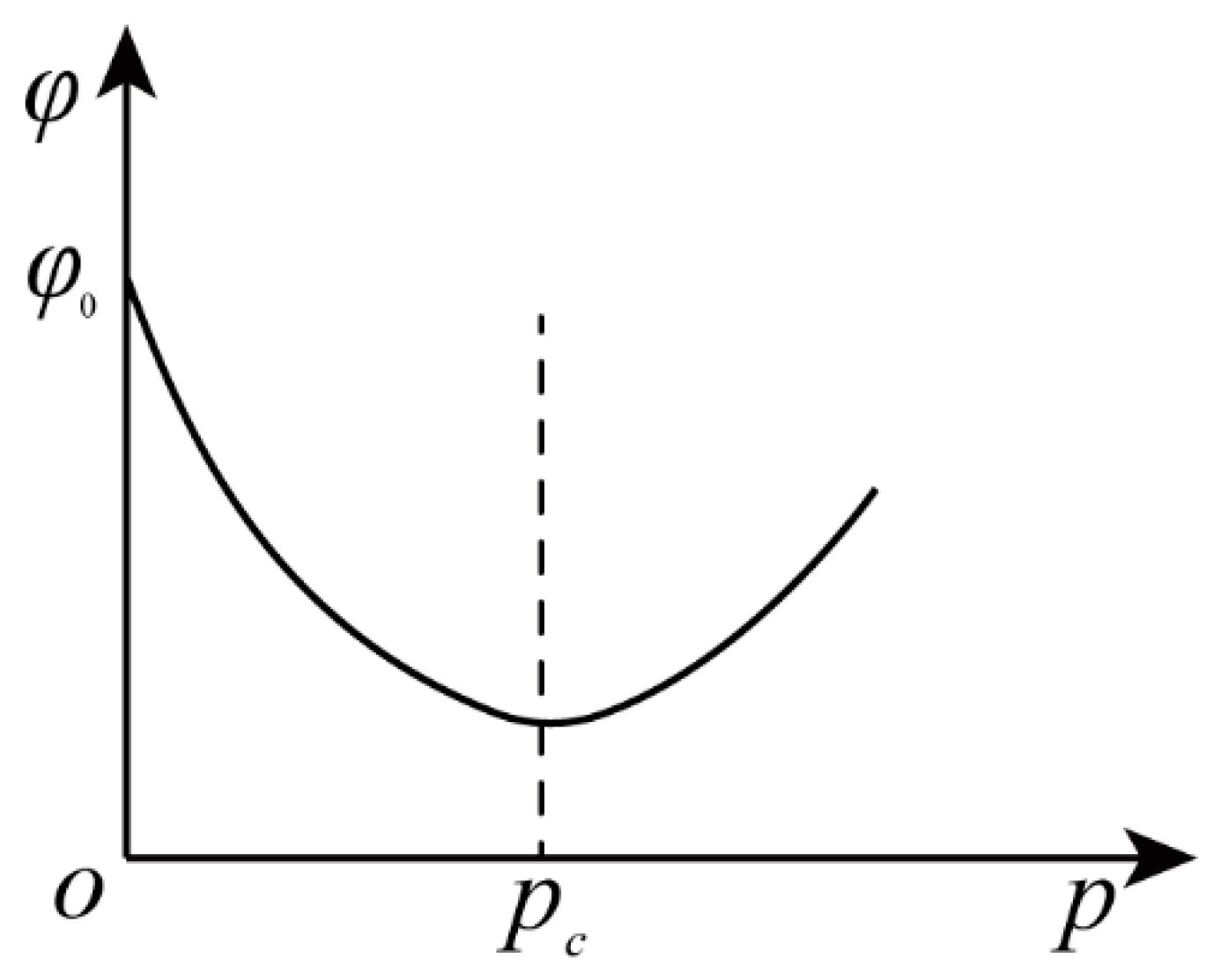
| Coal Sample Number | Type of Coal Structure | Length (mm) | Diameter (mm) | Fissure Development | R0,max | Vdaf (%) | Weight Capacity (t·m−3) |
|---|---|---|---|---|---|---|---|
| IX1 | Primary structural coal | 99.9 | 49.9 | Clearly stratified, no obvious fractures | 1.86 | 15.7% | 1.43 |
| IIX1 | Fractured structural coal | 99.9 | 50.1 | Generally clear lamination, a few fissures | 1.97 | 16.8% | 1.39 |
| Test No. | Shaft Pressure (MPa) | Surrounding Pressure (MPa) | Absolute Pressure (MPa) | Measurement Time (h) | Dissemination Time (×10−4 s) | Longitudinal Wave Velocity (m s−1) | Dissemination Time (×10−4 s) | Transverse Wave Velocity (m s−1) | Poisson’s Ratio ν | Elastic Modulus E (GPa) |
|---|---|---|---|---|---|---|---|---|---|---|
| 1 | 3.0 | 3.0 | 0.10 | - | 0.501 | 1995 | 0.924 | 1081 | 0.292 | 4.319 |
| 2 | 3.0 | 3.0 | 0.01 | - | 0.492 | 2031 | 0.914 | 1093 | 0.296 | 4.429 |
| 3 | 3.1 | 3.1 | 0.10 | 6 | 0.486 | 2056 | 0.906 | 1103 | 0.298 | 4.516 |
| 4 | 3.5 | 3.5 | 0.50 | 12 | 0.481 | 2075 | 0.900 | 1110 | 0.300 | 4.579 |
| 5 | 4.0 | 4.0 | 1.00 | 18 | 0.478 | 2092 | 0.895 | 1116 | 0.301 | 4.635 |
| 6 | 4.5 | 4.5 | 1.50 | 24 | 0.475 | 2103 | 0.891 | 1121 | 0.302 | 4.678 |
| 7 | 5.0 | 5.0 | 2.00 | 30 | 0.476 | 2100 | 0.886 | 1127 | 0.298 | 4.714 |
| 8 | 5.5 | 5.5 | 2.50 | 36 | 0.477 | 2095 | 0.883 | 1132 | 0.294 | 4.742 |
| 9 | 5.0 | 5.0 | 2.00 | 38 | 0.474 | 2106 | 0.884 | 1130 | 0.298 | 4.740 |
| 10 | 4.5 | 4.5 | 1.50 | 40 | 0.470 | 2125 | 0.888 | 1125 | 0.305 | 4.725 |
| 11 | 4.0 | 4.0 | 1.00 | 42 | 0.473 | 2110 | 0.893 | 1119 | 0.304 | 4.671 |
| 12 | 3.5 | 3.5 | 0.50 | 44 | 0.476 | 2098 | 0.896 | 1115 | 0.303 | 4.634 |
| 13 | 3.1 | 3.1 | 1.10 | 46 | 0.480 | 2081 | 0.900 | 1110 | 0.301 | 4.585 |
| Test No. | Shaft Pressure (MPa) | Surrounding Pressure (MPa) | Absolute Pressure (MPa) | Measurement Time (h) | Dissemination Time (×10−4 s) | Longitudinal Wave Velocity (m s−1) | Dissemination Time (×10−4 s) | Transverse Wave Velocity (m s−1) | Poisson’s Ratio ν | Elastic Modulus E (GPa) |
|---|---|---|---|---|---|---|---|---|---|---|
| 1 | 3.0 | 3.0 | 0.10 | - | 0.617 | 1618 | 1.181 | 846 | 0.312 | 2.610 |
| 2 | 3.0 | 3.0 | 0.01 | - | 0.580 | 1722 | 1.120 | 892 | 0.317 | 2.912 |
| 3 | 3.1 | 3.1 | 0.10 | 6 | 0.559 | 1786 | 1.089 | 917 | 0.321 | 3.088 |
| 4 | 3.5 | 3.5 | 0.50 | 12 | 0.544 | 1836 | 1.066 | 937 | 0.324 | 3.231 |
| 5 | 4.0 | 4.0 | 1.00 | 18 | 0.531 | 1882 | 1.046 | 955 | 0.327 | 3.364 |
| 6 | 4.5 | 4.5 | 1.50 | 24 | 0.519 | 1925 | 1.030 | 970 | 0.330 | 3.478 |
| 7 | 5.0 | 5.0 | 2.00 | 30 | 0.522 | 1915 | 1.014 | 985 | 0.320 | 3.561 |
| 8 | 5.5 | 5.5 | 2.50 | 36 | 0.525 | 1902 | 1.001 | 998 | 0.310 | 3.627 |
| 9 | 5.0 | 5.0 | 2.00 | 38 | 0.519 | 1926 | 1.009 | 990 | 0.320 | 3.598 |
| 10 | 4.5 | 4.5 | 1.50 | 40 | 0.513 | 1948 | 1.019 | 980 | 0.331 | 3.553 |
| 11 | 4.0 | 4.0 | 1.00 | 42 | 0.523 | 1910 | 1.035 | 965 | 0.329 | 3.440 |
| 12 | 3.5 | 3.5 | 0.50 | 44 | 0.533 | 1873 | 1.050 | 951 | 0.326 | 3.335 |
| 13 | 3.1 | 3.1 | 1.10 | 46 | 0.549 | 1821 | 1.072 | 932 | 0.323 | 3.194 |
| ρ/(t·m−3) | E/MPa | ν | a/(m3·t−1) | b/(MPa−1) | φ0 | T/K | CS/(MPa−1) | Vp/(m·s−1) | Vs/(m·s−1) |
|---|---|---|---|---|---|---|---|---|---|
| 1.43 | 4400 | 0.296 | 35.2 | 0.71 | 0.06 | 298 | 0.016 | 2031 | 1093 |
Publisher’s Note: MDPI stays neutral with regard to jurisdictional claims in published maps and institutional affiliations. |
© 2022 by the authors. Licensee MDPI, Basel, Switzerland. This article is an open access article distributed under the terms and conditions of the Creative Commons Attribution (CC BY) license (https://creativecommons.org/licenses/by/4.0/).
Share and Cite
Xu, G.; Liu, J.; Wang, Y.; Jin, H.; Wang, C. Experimental Study on the Effect of Gas Adsorption and Desorption on Ultrasonic Velocity and Elastic Mechanical Parameters of Coal. Sustainability 2022, 14, 15055. https://doi.org/10.3390/su142215055
Xu G, Liu J, Wang Y, Jin H, Wang C. Experimental Study on the Effect of Gas Adsorption and Desorption on Ultrasonic Velocity and Elastic Mechanical Parameters of Coal. Sustainability. 2022; 14(22):15055. https://doi.org/10.3390/su142215055
Chicago/Turabian StyleXu, Gang, Jiawei Liu, Yunlong Wang, Hongwei Jin, and Chaofeng Wang. 2022. "Experimental Study on the Effect of Gas Adsorption and Desorption on Ultrasonic Velocity and Elastic Mechanical Parameters of Coal" Sustainability 14, no. 22: 15055. https://doi.org/10.3390/su142215055
APA StyleXu, G., Liu, J., Wang, Y., Jin, H., & Wang, C. (2022). Experimental Study on the Effect of Gas Adsorption and Desorption on Ultrasonic Velocity and Elastic Mechanical Parameters of Coal. Sustainability, 14(22), 15055. https://doi.org/10.3390/su142215055










